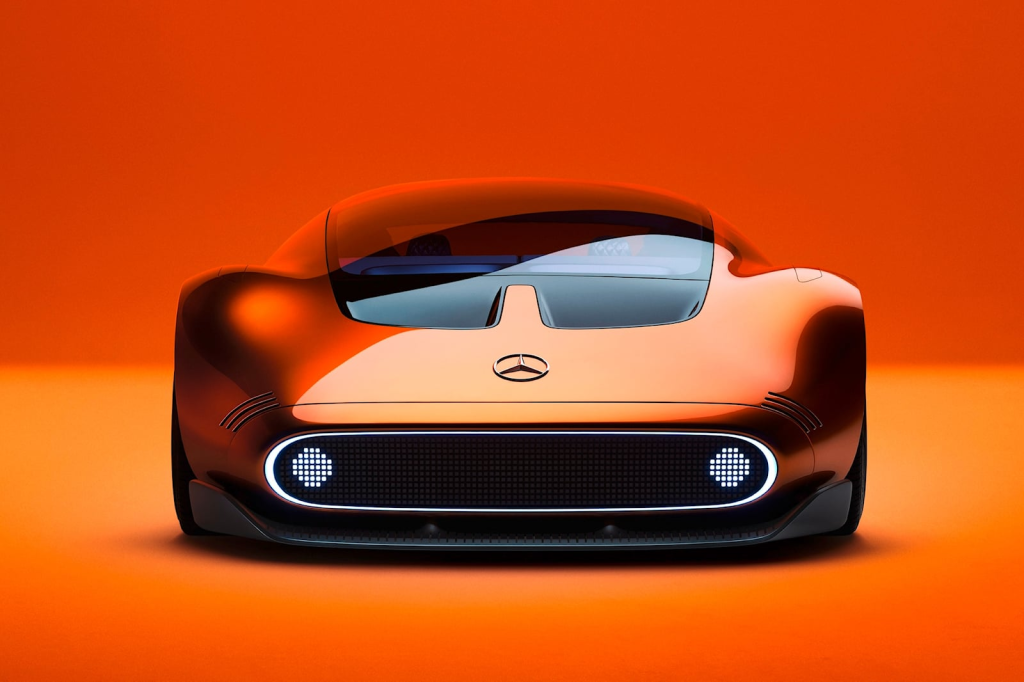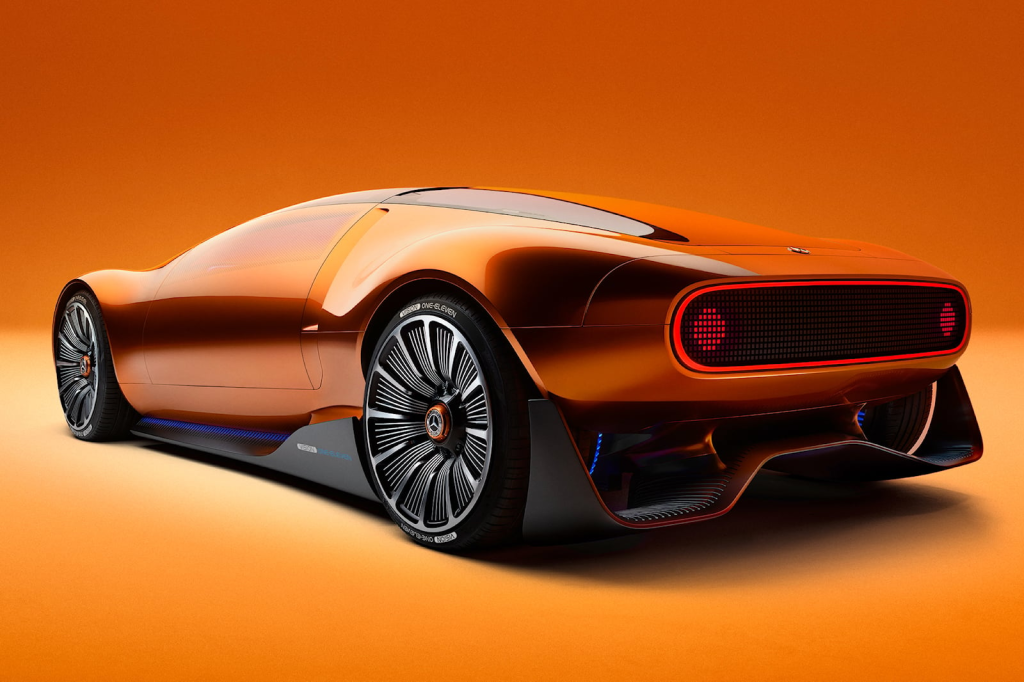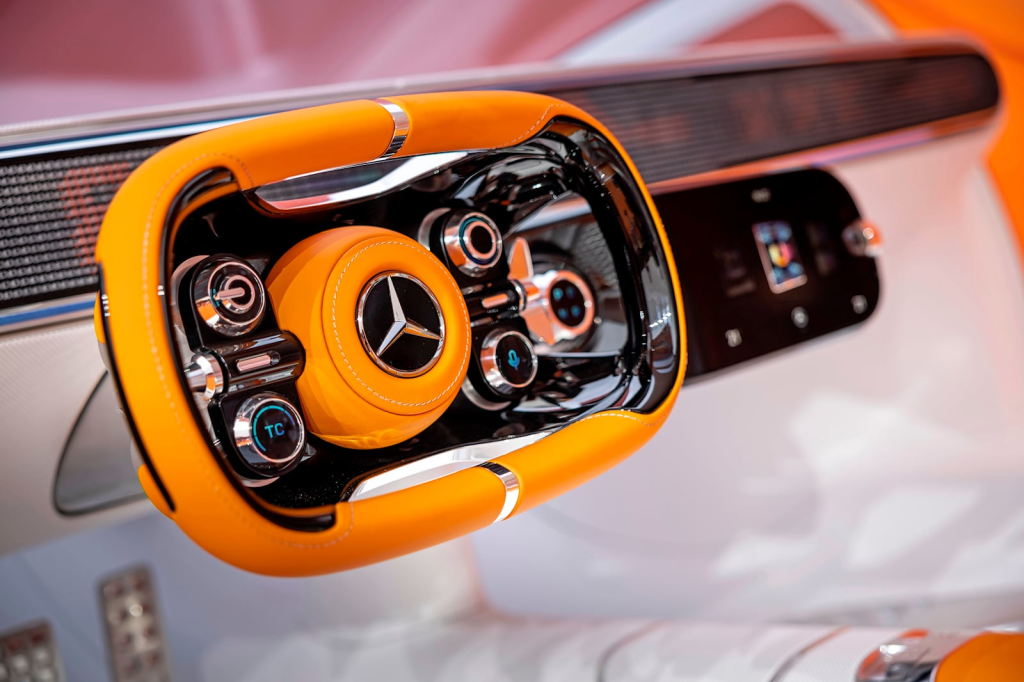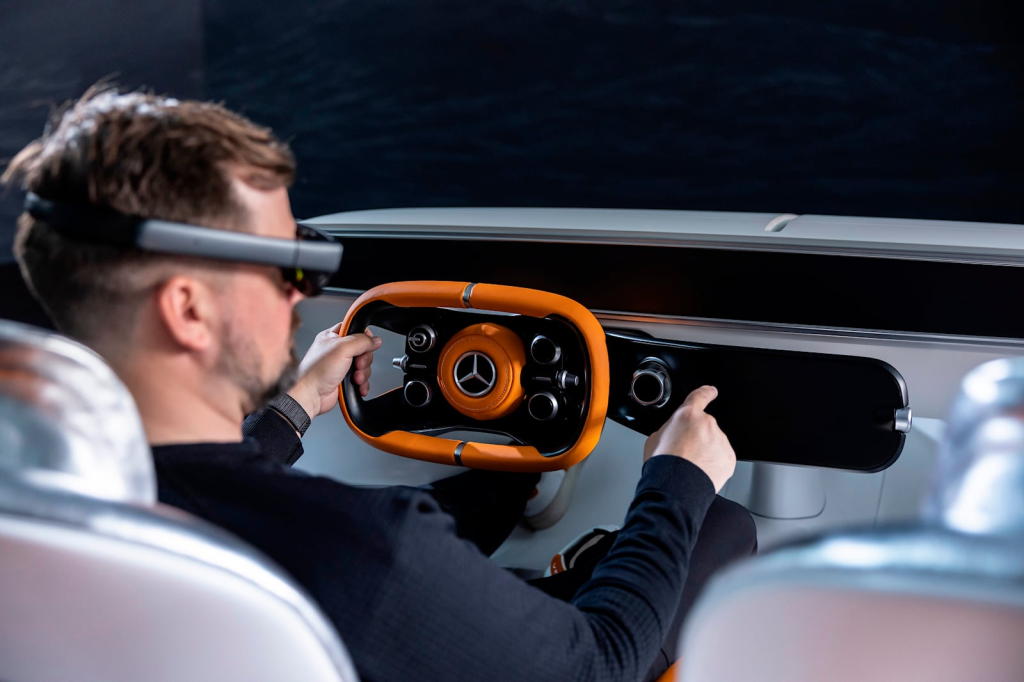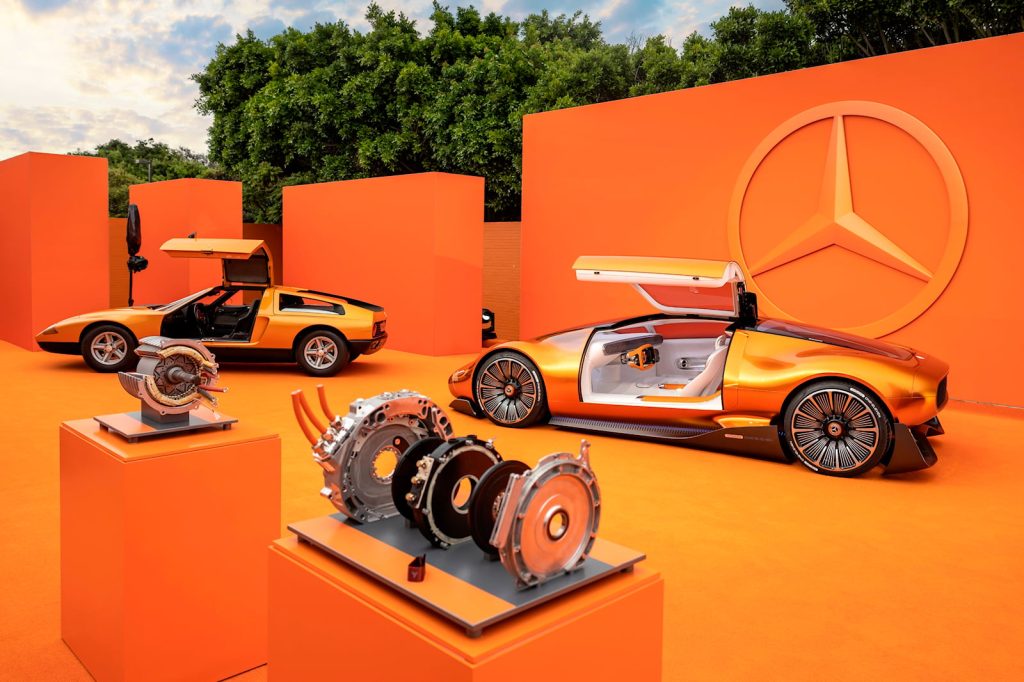Mercedes-Benz has recently introduced the Vision One-Eleven concept car, which pays homage to the legendary C 111 experimental vehicles. Mercedes-Benz Vision One-Eleven is an EQS Luxury Sedan. This modern interpretation of the C 111 is an extraordinary electric supercar featuring gullwing doors and cutting-edge motor technology, boasting an impressive power output of nearly 2,000 horsepower.
Although the C 111 is renowned for its experimental engines, including rotary and turbodiesel variants, its significance extends beyond sheer power. Mercedes utilized C 111 prototypes as testing grounds for pioneering polymer-based bodyshells. Additionally, the dedicated engineers meticulously crafted three different design iterations, culminating in the beloved orange and black supercar with its iconic gullwing doors.
Gorden Wagener, the Chief Design Officer of Mercedes-Benz Group, emphasizes the company’s commitment to crafting iconic vehicles rather than merely focusing on styling. He asserts that the Type 300 SL and C 111, both featuring gullwing doors, are integral parts of Mercedes-Benz’s identity. These legendary vehicles have profoundly influenced the striking design of the Mercedes-Benz Vision One-Eleven, embodying the pursuit of creating enduring icons.
Introducing the Retro Design
Mercedes-Benz Vision One-Eleven combines the best of both worlds: a timeless, iconic concept with Merc’s innovative One-Bow design language, which first made its appearance on the EQS Sedan. This concept showcases a cab-forward design made possible by the wonders of electrification.
The Vision One-Eleven boasts a sleek bow that gracefully sweeps across its body, accentuating its low front end and muscular rear. Standing at a mere 46 inches tall, it’s fascinating to see how the wheel arches extend above the primary convex design line. It almost appears as though the smooth body had to stretch to cover those massive wheels.
The choice of a vibrant orange hue is a deliberate homage to the classic C 111, although it’s not an exact replica. The Vision One-Eleven sports a deep orange shade with a touch of copper, resulting in a color that subtly changes depending on the play of light and angle.
LED Pixel Lighting
The front of the car bears a remarkable resemblance to the iconic C 111, capturing most of its timeless design features, except for the unfortunate absence of pop-up headlamps due to legal constraints. However, Mercedes has ingeniously replaced them with a digital insert that houses LEDs capable of mimicking the appearance of traditional fog lights. This cleverly designed panel can even display messages to other drivers on the road, adding an interactive element to the vehicle.
Maintaining the brand’s signature aesthetic, Mercedes has retained the lower air intakes positioned on either side of the renowned star emblem. This is prominently nestled beneath the contrasting black air intakes on the hood.
At the rear, the car boasts a digital display showcasing pixelated brake lights, contributing to a distinct visual appeal. Additionally, two prominent diffusers enhance the overall aerodynamic profile of the vehicle. Mercedes has gone a step further by illuminating the inner faces of the wheels with vibrant blue LEDs. It ensures their visibility from the rear.
Luxury Interior
Mercedes proudly introduces the One-Eleven, a groundbreaking sports car that redefines luxury with its innovative lounge interior. As Mercedes continues to push the boundaries of autonomous driving, the One-Eleven serves as a promising glimpse into the future. The company has already achieved Level 3 autonomy, and the next leap forward will allow drivers to confidently remove their hands from the wheel for extended periods.
To facilitate this transition, Mercedes-Benz Vision One-Eleven offers two distinct modes: Race Mode and Lounge Mode. In Race Mode, the backrest is upright, and the interior focuses on a compact driver-oriented touchscreen, creating a dynamic and engaging environment. On the other hand, Lounge Mode transforms the car’s interior into a seamless integration of seats and sculpted design elements, including a central tunnel and a luggage compartment. This setup grants both the driver and passenger the freedom to relax and enjoy the ride while the car takes charge.
Drawing inspiration from their Formula 1 team, Mercedes has incorporated elements of high-performance seating into the One-Eleven. The seat cushions are skillfully flush-fit to the floor and equipped with four-point harnesses, reminiscent of racing cars. However, unlike their F1 counterparts, these seats allow for adjustment, providing the option for rest and comfort when the vehicle assumes control. Upholstered in predominantly 100% recycled polyester materials, the interior showcases Mercedes’ commitment to sustainability. While not entirely vegan, the company assures us that the leather used was responsibly sourced and tanned using coffee bean husks, minimizing environmental impact.
The Wow Array of Screen
As expected, the interior features an array of screens, but with an intriguing twist. A high-definition screen takes care of the essential functions such as HVAC and infotainment, while a large dot matrix-like LED panel sits above, adding a touch of nostalgic charm. Although this retro-inspired design is captivating, its long-term appeal remains uncertain.
Thankfully, Mercedes emphasizes that there’s more to interior innovation than simply plastering screens on every available surface. They showcase their dedication to finding exciting and creative solutions that enhance the overall driving experience, setting the One-Eleven apart from the crowd.
Virtual Reality Vision Eliminates Blind Spots
When you take a glance at the One-Eleven from the side, it becomes evident that visibility might pose a challenge. With a low seat and a considerable distance between the driver and the front, Mercedes has devised two solutions to address this issue.
The first solution involves cutting-edge glass that appears opaque from the outside but becomes transparent from the inside. This innovative feature enhances the driver’s ability to see the surroundings.
The second solution is particularly fascinating: the utilization of augmented reality goggles while driving. By wearing the Magic Leap 2 augmented reality headset, the driver receives a crystal-clear digital feed that effectively eliminates the vehicle’s blind spots. This advanced system repositions the driver to the center of the car, offering a 180-degree panoramic view. While sporting the goggles, one can freely explore the cabin, with the virtual display accurately reflecting the physical elements that remain interactive.
Undoubtedly, this technology may feel somewhat unnatural to older drivers. Nonetheless, it will be intriguing to witness the future development and potential of this concept.
Powertrain and Performance
The Mercedes-Benz Vision One-Eleven boasts an exceptional powertrain that rivals hypercars. From a side view, two notable features catch the eye: the sleek gullwing doors, reminiscent of the iconic Type 300 SL and C 111 models.
However, the true gem lies in its groundbreaking components: the cutting-edge YASA axial-flux motor and liquid-cooled cylindrical-cell battery. Developed in collaboration with Mercedes-AMG High-Performance Powertrain in Brixworth, England – the masterminds behind the AMG One engine and Mercedes F1 powertrains – this high-performance duo steals the show.
Mercedes-Benz guarantees the integration of the YASA motor in its future electric vehicles. Unlike traditional radial flux motors, the YASA motor is one-third the size and weight, making it compact enough to be placed within the wheel. The Vision One-Eleven takes advantage of “up to four” of these motors, delivering an astonishing combined power of up to 1,920 horsepower and 2,360 lb-ft of torque – potentially surpassing the Rimac Nevera, the groundbreaking new standard in speed. Although the One-Eleven may not reach production, we eagerly anticipate Mercedes once again pushing the boundaries of what we define as fast.
The question remains whether Mercedes will pursue the creation of another top-tier hypercar like the One. Despite shattering the Nürburgring record, the team responsible for the One has already stated their hesitation to embark on such a project again. The feat of fitting an F1 engine into a street-legal car is no small feat, and we applaud Mercedes-AMG for daring to make it happen.
On the other hand, developing an all-electric hypercar would present a more feasible endeavor for Mercedes. Not only would it provide stiff competition to the Porsche Mission X, the forthcoming successor to the all-electric 918, but it would also streamline the development process.
Vision One-Eleven Price
Please note that there is no official price for the Vision One-Eleven concept car yet. However, there have been speculations and assumptions in the automotive community, suggesting a potential price point of around $122,000. It’s important to remember that this figure is not confirmed and may vary significantly when production starts. For accurate and up-to-date information on pricing, it is recommended to check back this page for the official price.
Conclusion
Mercedes-Benz has unveiled the Vision One-Eleven concept car, paying tribute to the iconic C 111 experimental vehicles of the past. This extraordinary electric supercar showcases impressive design elements and advanced motor technology, offering a glimpse into the future of automotive innovation. With its sleek gullwing doors and cutting-edge powertrain featuring the YASA axial-flux motor and liquid-cooled cylindrical-cell battery, the One-Eleven boasts exceptional performance potential, potentially surpassing even the groundbreaking Rimac Nevera. While the production of the One-Eleven remains uncertain, Mercedes-Benz continues to push the boundaries of speed and redefine what is considered fast.
Looking ahead, the question arises whether Mercedes will pursue the creation of another high-end hypercar like the One. Despite its record-breaking achievements, the challenges and complexities of integrating an F1 engine into a road-legal vehicle make it a formidable task. However, the prospect of developing an all-electric hypercar presents a more viable opportunity for the brand. Such a venture would not only provide competition to the Porsche Mission X, the anticipated successor to the all-electric 918, but also align with Mercedes’ commitment to advancing electric vehicle technology. As the automotive landscape continues to evolve, Mercedes-Benz remains at the forefront, pushing the boundaries of innovation and luxury.


